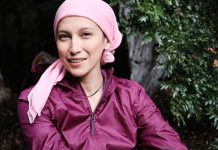
Breast reconstruction surgery can be a key part of recovery from treatment, yet many women don’t opt for it.
A breast cancer diagnosis rearranges priorities quickly for a woman. Along with possible treatments, such as hormone therapy, chemotherapy and radiation, most women also undergo surgical treatment which could include lumpectomy or mastectomy.
Once a successful course of treatment that includes a mastectomy ends, then what? For some women, part of recovery includes restoring a part of themselves that was removed.
Despite demonstrated psychosocial benefits breast reconstruction surgery can provide, some women either aren’t aware of all of the options available to them, or that they are candidates for reconstruction at all.
Jessica Hsu, M.D., Ph.D., a plastic surgeon at Michigan Medicine, says awareness is critical for women to make informed choices about how to proceed after cancer treatment.
“It’s a very personal decision. The important thing is to just have a conversation about all of the options,” Hsu says.
The options
Michigan Medicine has an integrated breast care clinic, and every woman diagnosed with breast cancer is offered a plastic surgery consultation.
Once a patient decides to pursue breast reconstruction after total mastectomy, they’ll likely be offered one of two main procedures offered at the clinic: Implant-based breast reconstruction or natural (also called autologous) tissue breast reconstruction.
Implant-based breast reconstruction uses implants that contain either silicone or saline, has a shorter recovery period and is the more common of the two procedures.
Complications with the implants can arise, however, particularly in the case of women requiring radiation as part of their cancer treatment.
Natural tissue breast reconstruction involves moving tissue from another part of the body—most often the patient’s abdomen—and using that tissue flap to reconstruct a breast mound.
It’s a procedure that Paige Myers, M.D., a plastic surgeon at Michigan Medicine, specializes in performing. Myers is trained in microvascular surgery, which is required to reconnect the blood supply from the donor tissue to the reconstruction site in some cases.
Breast reconstruction using natural tissue is generally a more involved surgery with a longer recovery time, with a higher immediate complication rate. The upside is that it offers women more natural looking breasts, with tissue that changes along with their bodies and fewer future surgeries over time.
“The benefits of autologous breast reconstruction surgery in people who are candidates for both tend to be more longevity of the reconstruction. The patients require fewer revisions down the road. It’s your own tissue, so it ages with you naturally,” Myers says.
Of course, one option is to not have reconstruction surgery to recreate breast mounds. As with all of the options, it’s a personal choice, and another one for women to consider.
“There’s been a lot written on the flat and fabulous crowd and that’s a form of breast reconstruction,” Hsu says. “They often still do have cosmetic concerns about their skin and we get involved in those cases.”
The benefits
Some women may not be interested in more surgery after undergoing a mastectomy. Hsu sees reconstruction as part of the treatment and recovery process, and points to the confidence women gain after reconstruction.
“A lot of people think that the purpose of surgery is to restore function only, and they forget the other part, which is form,” Hsu says. “To help a woman have symmetric breasts after breast cancer surgery so they feel good in their clothing or in a swimsuit, and feel more like a woman with breast mounds, is really important—and really important to me.”
Myers has seen examples of the powerful effects that breast reconstruction can have on a woman’s mental wellbeing. A happy patient once shared a photo of her son trying to breastfeed from a reconstructed breast after her surgery. To both mother and son, things seemed familiar in a way that was comforting.
According to Myers, so much of the breast cancer journey involves loss of control, and empowering women to determine what their bodies look like after mastectomy is another benefit.
“Cancer diagnosis, therapy and everything that ensues takes so much away from patients,” Myers says. “To be in control of their own course of care, and what they feel is best for them, is another huge benefit.”
The barriers
Many barriers keep women from seeking a consultation or pursuing breast reconstruction surgery. Information overload is an issue for women who are already receiving a breast cancer diagnosis and the ensuing treatment.
Hsu’s typical consultations last about an hour. Women leave armed with pamphlets and are followed up closely to see if they have additional questions. It’s a thorough process, but Hsu thinks there’s room to improve the way information is delivered.
“Our patients range from younger than 20 to people in their 70s and 80s, so it’s important to have resources that work for different age groups and different levels of technical comfort,” Hsu says. There is an active effort at Michigan Medicine, led by Edwin Wilkins, M.D., to improve patient education resources and decision aids for breast reconstruction.
Myers understands that reconstruction takes a mental back seat to treatment.
“When first faced with a cancer diagnosis, women are flooded with emotions and an onslaught of information,” Myers says. “Survival is the main thing on their minds, and that should be their priority. They receive all this information and then it seems reconstruction is put on the back burner.”
The way the University of Michigan Rogel Cancer Center’s multidisciplinary Breast Care Center brings the various treatment teams together helps to keep the options more top of mind for patients. According to Myers, not every health care setting has an integrated approach or structure.
Sometimes patients have trouble simply finding a clinic that can perform the surgeries. In some cases, a provider may not be able to offer an option that works— and may not refer women elsewhere.
“Women may not have access to a microsurgeon, geographically or otherwise, to perform the autologous reconstruction and, therefore, this can be a huge barrier for patients who aren’t candidates for implant-based reconstruction,” Myers says.
The expense of breast reconstruction surgery may also deter women, especially if they don’t think the results will be worth it. Hsu says it’s important to note that most group insurance providers that cover mastectomies are also required to cover breast reconstruction surgery, and that the coverage is more comprehensive than women might assume.
“Coverage includes revision on the other side to achieve symmetry,” Hsu says. “Patients who are undergoing mastectomy on one side worry they won’t be able to match the other side that didn’t have cancer so they sometimes don’t pursue it.”
Hsu stresses that she and the rest of the team are eager to help women navigate questions and barriers, and to walk them through the options so that they ultimately make the decision that’s right for them.
“If you have questions, I’m here,” Hsu says. “If you want to meet in five years, I’m here. If you don’t want to do it, that’s your choice, and that’s fine, too.”
Written by Colleen Stone.



